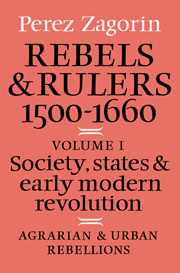3 - The society of orders
Published online by Cambridge University Press: 12 January 2010
Summary
The society that the European revolutions of the sixteenth and seventeenth centuries occurred in and that entered into their nature and established their limits was profoundly different from our own. Not merely its main component groups were different, but so was the essential basis of its stratification. In our present conception or picture of society, we naturally tend to think first of economic classes and to consider class in this sense as the most important collectivity as well as perhaps the controlling reality in political and social action. Early modern society was not a class society, however, and therefore presented an alternative type of structure. Although latter-day historians who have written about this society have provided all the material necessary for its correct understanding, they have often failed to draw the full theoretical conclusions from their own descriptions. Hence confusion and disagreement as to the sort of society it was have persisted. But if we consider it systematically, it is evident that it was not homologous with the society destined to displace it after the eighteenth century and that it incorporated a differently determined structure.
In using the collective singular, “early modern society,” I do not of course mean to imply that we might not equally well speak of “societies.” Europe did, after all, consist of plural societies, and the distinctions among them also decisively affected their revolutions. We could not simply superpose an account of the English social order on that which enclosed the peoples ruled by the French or Spanish monarchies.
- Type
- Chapter
- Information
- Rebels and Rulers, 1500–1600Society, States, and Early Modern Revolution, pp. 61 - 86Publisher: Cambridge University PressPrint publication year: 1982

